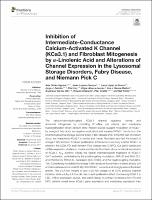Por favor, use este identificador para citar o enlazar este ítem:
https://repositorio.usj.es/handle/123456789/251
| Título : | Inhibition of Intermediate-Conductance Calcium-Activated K Channel (KCa3.1) and Fibroblast Mitogenesis by α-Linolenic Acid and Alterations of Channel Expression in the Lysosomal Storage Disorders, Fabry Disease, and Niemann Pick C |
| Autor: | Olivan-Viguera, Aida


Lozano-Gerona, Javier 

López de Frutos, Laura 

Cebolla, Jorge Javier 


Irún, Pilar 


Abarca-Lachén, Edgar 


García-Malinis, Ana J. 

García-Otín, Ángel Luis 


Gilaberte, Yolanda 


Giraldo, Pilar 


Köhler, Ralf 

|
| Palabras clave : | KCa3.1/SK4 channel; Linolenic acids; Fabry disease; Fibroblasts; Ion channel pharmacology |
| Fecha de publicación: | 31-may-2017 |
| Editorial : | Mauricio Antonio Retamal, Universidad del Desarrollo, Chile |
| Citación : | Oliván-Viguera A, Lozano-Gerona J, López de Frutos L, Cebolla JJ, Irún P, Abarca-Lachen E, García-Malinis AJ, García-Otín ÁL, Gilaberte Y, Giraldo P and Köhler R (2017) Inhibition of Intermediate-Conductance Calcium-Activated K Channel (KCa3.1) and Fibroblast Mitogenesis by α-Linolenic Acid and Alterations of Channel Expression in the Lysosomal Storage Disorders, Fabry Disease, and Niemann Pick C. Front. Physiol. 8:39. doi: 10.3389/fphys.2017.00039 |
| Resumen : | The calcium/calmodulin-gated KCa3.1 channel regulates normal and abnormal mitogenesis by controlling K+-efflux, cell volume, and membrane hyperpolarization-driven calcium-entry. Recent studies suggest modulation of KCa3.1 by omega-3 fatty acids as negative modulators and impaired KCa3.1 functions in the inherited lysosomal storage disorder (LSD), Fabry disease (FD). In the first part of present study, we characterize KCa3.1 in murine and human fibroblasts and test the impact of omega-3 fatty acids on fibroblast proliferation. In the second, we study whether KCa3.1 is altered in the LSDs, FD, and Niemann-Pick disease type C (NPC). Our patch-clamp and mRNA-expression studies on murine and human fibroblasts show functional expression of KCa3.1. KCa currents display the typical pharmacological fingerprint of KCa3.1: Ca2+-activation, potentiation by the positive-gating modulators, SKA-31 and SKA-121, and inhibition by TRAM-34, Senicapoc (ICA-17043), and the negative-gating modulator, 13b. Considering modulation by omega-3 fatty acids we found that α-linolenic acid (α-LA) and docosahexanenoic acid (DHA) inhibit KCa3.1 currents and strongly reduce fibroblast growth. The α-LA-rich linseed oil and γ-LA-rich borage oil at 0.5% produce channel inhibition while α-LA/γ-LA-low oils has no anti-proliferative effect. Concerning KCa3.1 in LSD, mRNA expression studies, and patch-clamp on primary fibroblasts from FD and NPC patients reveal lower KCa3.1-gene expression and membrane expression than Oliván-Viguera et al. Regulation of KCa3.1 by α-LA and in LSDs in control fibroblasts. In conclusion, the omega-3 fatty acid, α-LA, and α-LA/γ-LA-rich plant oils, inhibit fibroblast KCa3.1 channels and mitogenesis. Reduced fibroblast KCa3.1 functions are a feature and possible biomarker of cell dysfunction in FD and NPC and supports the concept that biased lipid metabolism is capable of negatively modulating KCa3.1 expression. |
| URI : | https://repositorio.usj.es/handle/123456789/251 |
| ISSN : | 1664-042X |
| Aparece en las colecciones: | Artículos de revistas |
Ficheros en este ítem:
| Fichero | Descripción | Tamaño | Formato | |
|---|---|---|---|---|
| fphys-08-00039.pdf | 1,01 MB | Adobe PDF |  Visualizar/Abrir |
Este ítem está sujeto a una licencia Creative Commons Licencia Creative Commons

